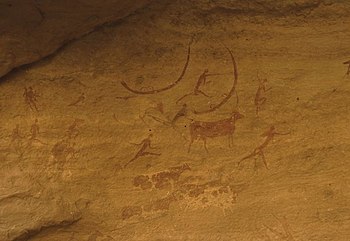
Pastoral rock art is the most common form of Central Saharan rock art, created in painted and engraved styles[1] depicting pastoralists and bow-wielding hunters in scenes of animal husbandry, along with various animals (e.g., cattle, sheep, goats, dogs),[2] spanning from 6300 BCE[3] to 700 BCE.[4] The Pastoral Period is preceded by the Round Head Period and followed by the Caballine Period.[5] The Early Pastoral Period spanned from 6300 BCE to 5400 BCE.[3] Domesticated cattle were brought to the Central Sahara (e.g., Tadrart Acacus), and given the opportunity for becoming socially distinguished, to develop food surplus, as well as to acquire and aggregate wealth, led to the adoption of a cattle pastoral economy by some Central Saharan hunter-gatherers of the Late Acacus.[6] In exchange, cultural information regarding utilization of vegetation (e.g., Cenchrus, Digitaria) in the Central Sahara (e.g., Uan Tabu, Uan Muhuggiag) was shared by Late Acacus hunter-gatherers with incoming Early Pastoral peoples.[6]
The Middle Pastoral Period (5200 cal BCE – 3800 cal BCE) is when most of the Pastoral rock art was developed.[7] In the Messak region of southwestern Libya, there were cattle remains set in areas in proximity to engraved Pastoral rock art depicting cattle (e.g., rituals of cattle sacrifice).[8] Stone monuments are also often found in proximity to these engraved Pastoral rock art.[8] A complete cattle pastoral economy (e.g., dairying) developed in the Acacus and Messak regions of southwestern Libya.[8] Semi-sedentary settlements were used seasonally by Middle Pastoral peoples depending on the weather patterns (e.g., monsoon).[8]
Amid the Late Pastoral Period, animals associated with the modern savanna decreased in appearance on Central Saharan rock art and animals suited for dry environments and animals associated with the modern Sahelian increased in appearance on Central Saharan rock art.[3] At Takarkori rockshelter, between 5000 BP and 4200 BP, Late Pastoral peoples herded goats, seasonally (e.g., winter), and began a millennia-long tradition of creating megalithic monuments, utilized as funerary sites where individuals were buried in stone-covered tumuli that were usually away from areas of dwellings in 5000 BP.[9]
The Final Pastoral Period (1500 BCE – 700 BCE) was a transitory period from nomadic pastoralism toward becoming increasingly sedentary.[4] Final Pastoral peoples were scattered, semi-migratory groups who practiced transhumance.[4] Burial mounds (e.g., conical tumuli, v-type) were created set a part from others and small-sized burial mounds were created closely together.[4] Final Pastoral peoples kept small pastoral animals (e.g., goats) and increasingly utilized plants.[4][10] At Takarkori rockshelter, Final Pastoral peoples created burial sites for several hundred individuals that contained non-local, luxury goods and drum-type architecture in 3000 BP, which made way for the development of the Garamantian civilization.[9]
- ^ Gallinaro, Marina; Di Lernia, Savino (November 2011). "Working in a UNESCO WH site. problems and practices on the rock art of tadrart akakus (SW Libya, central Sahara)". Journal of African Archaeology. 9 (2): 162, 167, 169, 173. doi:10.3213/2191-5784-10198. ISSN 1612-1651. OCLC 7787754660. S2CID 162084812.
- ^ Coulson, David; Campbell, Alec (2010). "Rock Art of the Tassili n Ajjer, Algeria" (PDF). Adoranten: 30, 33, 35.
- ^ a b c Guagnin, Maria (February 2015). "Animal engravings in the central Sahara: A proxy of a proxy". Environmental Archaeology. 20 (1): 1–2, 12. doi:10.1179/1749631414Y.0000000026. ISSN 1461-4103. OCLC 8659976399. S2CID 128628375.
- ^ a b c d e Mori, Lucia; et al. (October 2013). Life and death at Fewet. Edizioni All'Insegna del Giglio. p. 374. doi:10.1400/220016. ISBN 9788878145948. OCLC 881264296. S2CID 159219731.
- ^ Soukopova, Jitka (2017). "Central Saharan rock art: Considering the kettles and cupules". Journal of Arid Environments. 143: 10–12. Bibcode:2017JArEn.143...10S. doi:10.1016/j.jaridenv.2016.12.011. ISSN 0140-1963. OCLC 7044514678. S2CID 132225521.
- ^ a b Garcea, Elena A.A. (July 2019). "Cultural adaptations at Uan Tabu from the Upper Pleistocene to the Late Holocene". Uan Tabu in the Settlement History of the Libyan Sahara. All’Insegna del Giglio. pp. 232–235. ISBN 9788878141841. OCLC 48360794. S2CID 133766878.
- ^ Gallinaro, Marina; Di Lernia, Savino (2018). "Trapping or tethering stones (TS): A multifunctional device in the Pastoral Neolithic of the Sahara". PLOS ONE. 13 (1): e0191765. Bibcode:2018PLoSO..1391765G. doi:10.1371/journal.pone.0191765. ISSN 1932-6203. OCLC 7315414106. PMC 5784975. PMID 29370242.
- ^ a b c d Di Lernia, Savino; et al. (2013). "Inside the "African Cattle Complex": Animal Burials in the Holocene Central Sahara". PLOS ONE. 8 (2): e56879. Bibcode:2013PLoSO...856879D. doi:10.1371/journal.pone.0056879. ISSN 1932-6203. OCLC 828565064. PMC 3577651. PMID 23437260. S2CID 4057938.
- ^ a b Di Lernia, Savino; Tafuri, Mary Anne (March 2013). "Persistent deathplaces and mobile landmarks: The Holocene mortuary and isotopic record from Wadi Takarkori (SW Libya)". Journal of Anthropological Archaeology. 32: 3–5, 8–14. doi:10.1016/J.JAA.2012.07.002. hdl:11573/491908. ISSN 0278-4165. OCLC 5902856678. S2CID 144968825.
- ^ Di Lernia, Savino (June 2013). "Places, monuments, and landscape: Evidence from the Holocene central Sahara". Azania: Archaeological Research in Africa. 48 (2): 176, 179–181, 183–186. doi:10.1080/0067270X.2013.788867. hdl:11573/514585. ISSN 0067-270X. OCLC 5136086464. S2CID 162877973.
© MMXXIII Rich X Search. We shall prevail. All rights reserved. Rich X Search
